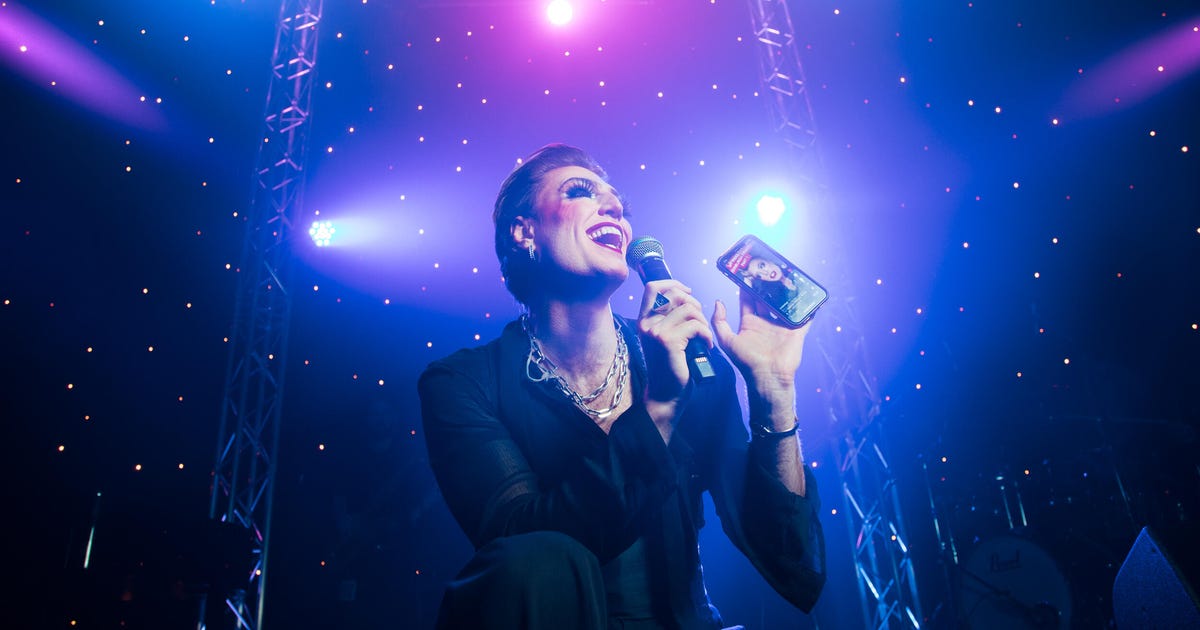
As the lights dim, the doors fly open and the shadow of Reuben Kaye — “actress, model and,” as he tells his audience every night, “the only horseman of the apocalypse to ride side saddle” — is thrown across the auditorium, stretching up the wall like something from your wildest fever dream.
With over 3,500 shows at this year’s Edinburgh Fringe — the world’s biggest arts festival, which runs in the capital every year for all of August — it’s pretty hard to stand out if you’re a performer wanting to make a name for yourself. But there are shows, and then there are the jazz-hands, capital-letters *SHOWS.*
Kaye’s The Butch Is Back is definitely the latter. Whereas many Fringe shows happen in the city’s rabbit warren of old vaults, upstairs at pubs and in hotel conference rooms, with very little in the way of lighting, backdrops and tech, Kaye’s is a Las Vegas show in miniature. With his band, he sings, dances and interacts with the audience with rapid-fire patter and comedic timing that fills the high ceilings of the old church he performs in with hoots and screeches.
This isn’t Kaye’s first rodeo at the Fringe, but he returns in 2022 after two years of being restricted to his homeland of Australia with some new tricks up his sleeve. Since his last Fringe run, Kaye has found success on TikTok, where he has 203,000 followers, which has not only opened him up to new audiences, but forced him to write faster and better in a way that’s transformed his shows.
“This show is pretty much a TikTok, it does not stop,” he said in an interview in the bar of Fringe venue Assembly Checkpoint last week. “The opening number and the closing number are written as TikToks — line after line after line, boom, boom, boom, costume change — as quick as it can be. And it’s also amazing cardio.”
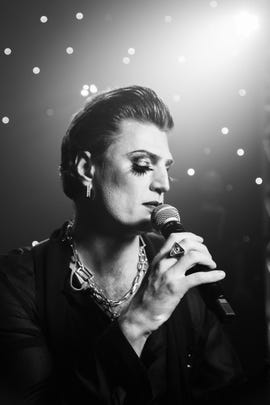
Reuben Kaye on stage in Edinburgh.
Andrew Lanxon/CNET
Kaye’s act isn’t the only place where TikTok has made its mark. The short-form video app’s fingerprints are all over the Fringe this year, shaking up the 75-year-old arts festival with an injection of new talent and energy. Freshly TikTok-famous comedians have come to the Fringe for the first time, buoyed by their online success, while old hands are using the platform to find new audiences and experiment with material.
“The Edinburgh Fringe is all about offering anyone a stage and everyone a seat — and that’s the ethos of TikTok too,” said Melissa McFarlane, head of content programming at TikTok, in a statement.
TikTok, which has enjoyed an explosion of popularity over the last few years (now at over 1 billion active monthly users, compared to 2.1 billion on YouTube and 2.9 billion on Facebook), boasts a physical presence in Edinburgh as the festival’s first virtual partner. The company broadcasts live on its own platform from the TikTok stage, invites creators to make use of its live studio in the heart of Edinburgh and works with performers to hone their TikTok skills.
The result: a festival with more original and unique acts for audiences, and new opportunities for a more diverse group of performers who might not have necessarily gotten a shot in this notoriously difficult business.
“It opened me up to a new demographic of people who would not have thought cabaret was for them,” said Kaye. “TikTok comedians are incredibly — to use an overused phrase — diverse. They’re people of color, they’re queer, they’re trans women and comedy has for a very long time been a white boys club.”
A ball for debutantes
One of those who performed on TikTok’s stage was Serena Terry from Derry, Northern Ireland, who on TikTok goes by Mammy Banter. With 1.4 million followers, Terry is popular for her sketches of parenting petulant children and teens, but until TikTok reached out inviting her to take one of its one-off standup spots she’d never performed live comedy.
“It’s incredible that TikTok can create these opportunities for people who have just jumped on the app in the last few years and haven’t done any standup comedy, but have established themselves in the digital world,” she said. “Absolute superstars have been born at the Fringe, so it was just a no-brainer for me.”
She had just two weeks to write and learn her show, but the experience has given her a taste for live performance. “It really has got me excited and it’s taken me out of my comfort zone in a very good way,” she said. Now she’s considering bringing back a full show next year.
Other comedians who found success on TikTok during the pandemic have brought their debut shows to Edinburgh for the entire month-long run.
After dancer and choreographer Christopher Hall lost all of his work for the third time in the UK’s series of COVID-19 lockdowns, he decided that it was finally time to do what he’d long dreamed of and try his hand at comedy. He’d held back from posting on TikTok, in part due to worrying what others would think, but the isolation of lockdown gave him a safety net.
“If everyone thought it was stupid, I wasn’t gonna see them for at least six months,” he said. “Because it just started off with zero followers, I was like, it could either blow up, or it could just be a sketchbook of ideas.”
Hall wrote videos based on what he was experiencing at the time: being a millennial forced to move back in with his parents. He posted one TikTok per day and on the fifth day he scored his first viral 100,000-view hit. He now has more than 130,000 followers and is in the middle of a month-long Fringe run of a two-man comedy show Two Sour Gays, with fellow comic Mark Bittlestone.
Among those making their Fringe debuts after finding success on TikTok, many have harbored long-running ambitions of working in comedy that finally came to fruition during the pandemic.
Like Hall, sisters Chloe and Tabby Tingey had a background in musical theater before making musical comedy TikToks during lockdown. Tabby had studied musical theater at Glasgow Conservatory and Chloe had won a scholarship to study songwriting at Berklee College of Music, but both had long given up on their dreams of working in the arts by the time they moved in together during the pandemic. Everything that came next was a “happy accident,” said Chloe.
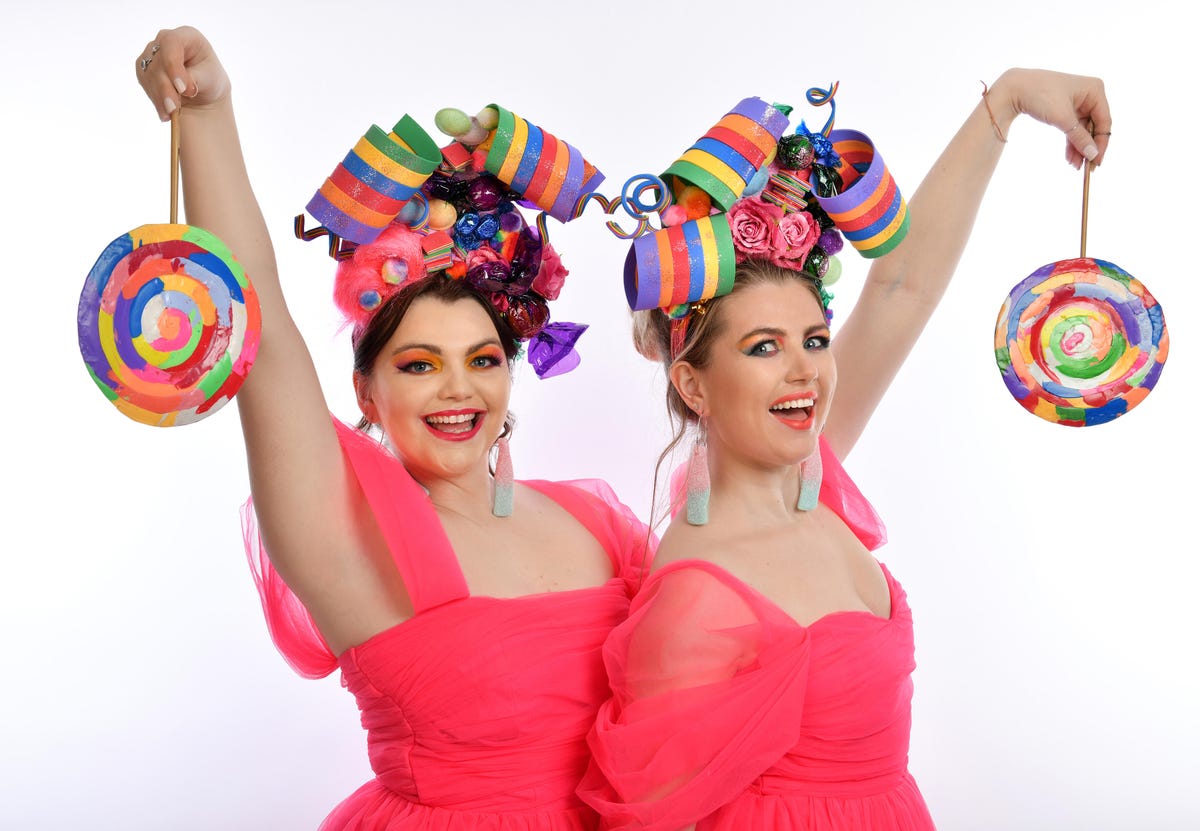
Chloe and Tabby Tingey are the Sugarcoated Sisters.
Steve Ullathorne
They started making TikTok videos of Tabby weightlifting Chloe — “she’s very strong, she’s like an ox,” Chloe said of her sister. But after discovering comedy content on the app they switched to making musical parodies, with a video of them making fun of Chicago’s Cell Block Tango being their first big hit.
After winning best newcomer at the UK’s Musical Comedy Awards earlier this year and racking up 401,000 followers, the pair, who collectively go by the Sugarcoated Sisters, decided to try the festival. TikTok has supported them by securing a spot on the inside front page of the Fringe brochure and putting them on digital bulletin boards.
Selling out shows
Edinburgh Fringe has a reputation for being a star maker, having launched the careers of performers and writers including Phoebe Waller-Bridge, Bo Burnham and Robin Williams. But the reality for many performers is that they will shell out their savings to bring a show to the festival and then have to perform it every night to mostly empty rooms.
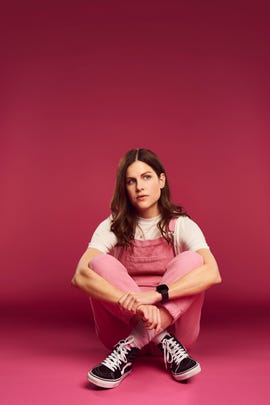
Micky Overman is at the Fringe for the third time.
Matt Crockett
It’s especially tough for new performers who haven’t already established an audience to help them sell out their rooms. “There’s a lot of pressure on people coming here for the first time.” said Micky Overman, a comic on her third Fringe run with her show Small Deaths. But she’s noticed that debut acts from TikTok aren’t struggling in the same way as others. “New people that are debuting and people who are successful online are properly selling their shows this year,” she said.
The livestreams on TikTok’s virtual stage have translated into real-world ticket sales, according to McFarlane. There’s no way for artists to tell for sure how many people are coming to shows solely because of TikTok, but it’s harder to find a spare seat at shows with those who boast huge followings. The comedian Rosie Holt, who is known for her online political satire, had to add extra performances after the whole run sold out before the festival even started — something that’s almost unheard of aside from the most famous names.
“We’re very charmed in the fact that our followings online seem to really translate to in-person audiences,” said Hall. He and his comedy partner both have largely UK-based followings that led to near sold-out shows. It’s not so easy to fill Edinburgh seats if your following is more international.
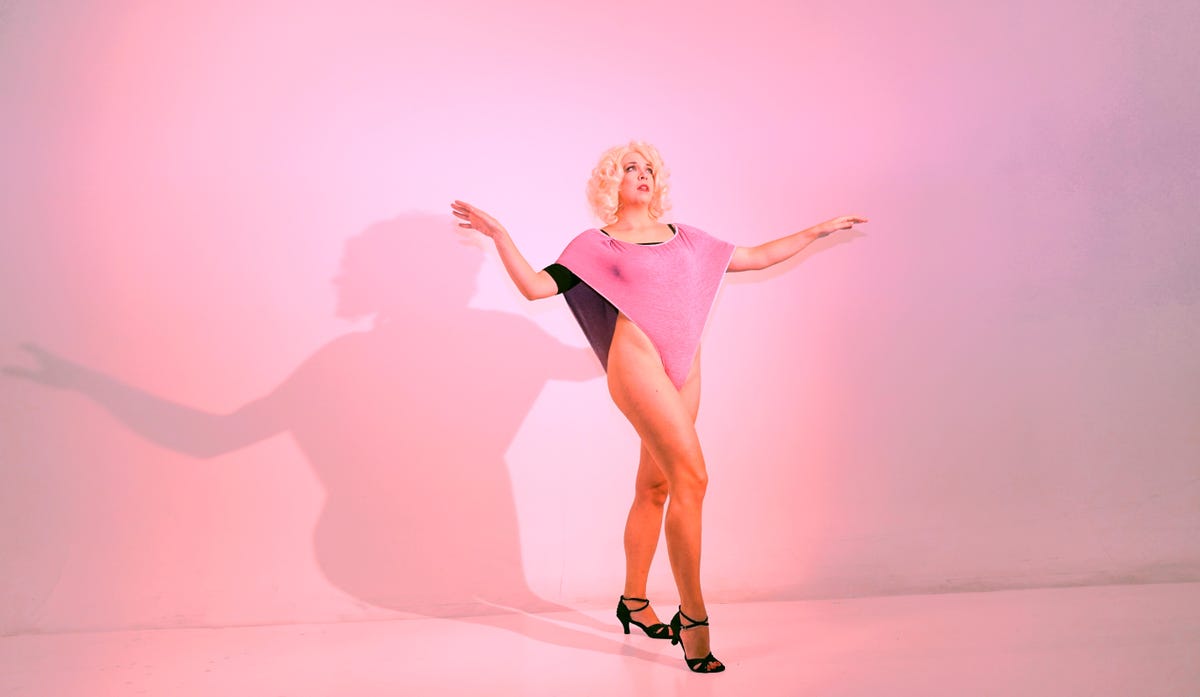
Shirley Gnome got on TikTok during the pandemic.
Shirley Gnome
Chloe and Tabby Tingey were unsure what impact their following would have on ticket sales given that only half of their audience is based in the UK. But they usually get people coming to them at the end of shows identifying themselves as followers, with one woman flying all the way from Illinois to see them live. “She stayed for four days and had a whale of a time,” said Tabby.
Finlay Christie, a debut act who has regularly been selling out his show OK Zoomer after shooting to fame on TikTok (173,000 followers), described feeling “the looming specter of digital” at this year’s Fringe. “You see the odd act up here who’s got a following and bringing their show up here and selling out, but it still feels like you’re trying to impress the gatekeepers,” he said. Most newer acts have been assigned to smaller rooms, but he said he wouldn’t be surprised if in the next few years they’re headlining big venues.
Comedy is a notoriously difficult industry to get into, involving immense financial risk and relying on club promoters to book acts. TikTok is changing this, said Hall, as it paves the way for people of all races, sexualities, genders and socio-economic backgrounds to get a leg up in an industry that might have otherwise been inaccessible to them. It can help prove that minority acts have mass-market appeal.
Form dictating content
Comedians who have succeeded at TikTok have seen a massive influx of new interest in their work. At the Fringe, this lifts some of the need to pass out flyers. “It’s not like here where you’re just shouting into the wind and hoping people walk past,” said Kaye.
TikTok’s algorithm makes it much easier to reach people who will appreciate you, weeding out those who never would have come to see you live anyway, said Lara Ricote, who is performing her show GRL/LATNX/DEF at the Fringe for the first time. “It’s like, oh, you love hard-of-hearing comedy? Guess what I do?” she said. “That difference is very cool. You can arrive at it quicker when usually it’s a freakin’ 25-year process to find your audience.”
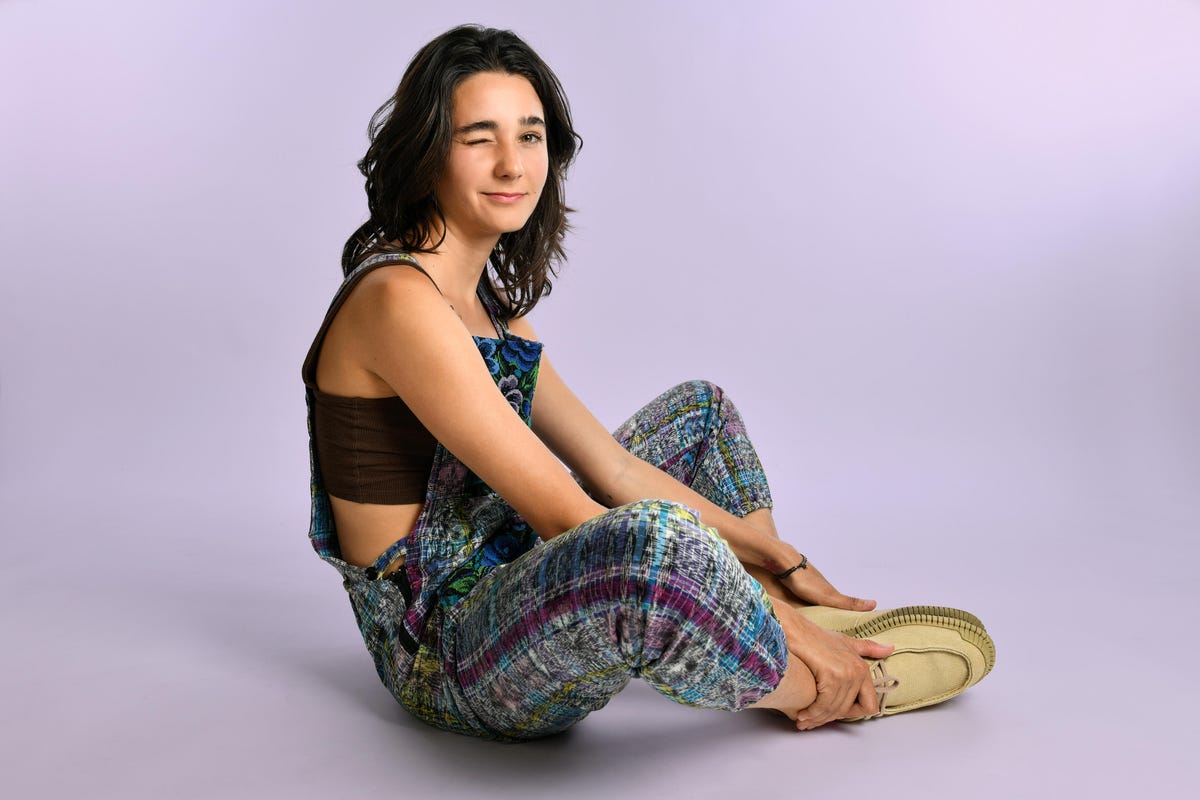
Lara Ricote’s show is about what it’s like to be Latin, hard of hearing and a girl.
Steve Ullathorne
The algorithm has delivered the Sugarcoated Sisters a following of good-humored musical theater lovers. “They’re so specific and genius at tailoring the content to people who are interested in it,” said Tabby. “It seems like the kind of community that they’re creating around the Edinburgh Fringe on TikTok is really supportive, really engaged.”
But it’s not just about reeling audiences in, said Overman. It’s equally valuable in ensuring that people who come to see your show and enjoy it can find more content when they look you up after. “Give them something that they come back to,” she said. It’s not like newer comics have Netflix specials they can point people towards, she added, but TikTok allows fans to connect with more of their content. “That’s how they can become invested.”
The Sugarcoated Sisters’ most viral hit — an original song about Chloe’s bipolar and Tabby’s diabetes, which they thought might be too niche to resonate at the time of writing — is now the opener to their show. But on the whole, it’s rare to see much overlap between a comedian’s stage show and their TikTok presence.
If there is crossover, it tends to be that TikTok informs the live comedy rather than the other way around. “I definitely have incorporated things that were popular on TikTok back into my show,” said Shirley Gnome, who found TikTok to be a great way of testing out what material was resonating best among audiences during the pandemic.
The adage that content dictates form doesn’t apply to TikTok, said Kaye. It’s usually the other way around. Many existing stand-up comedy acts have found success using TikTok for sketch and character-based comedy, which is somewhat out of fashion at the Fringe right now.
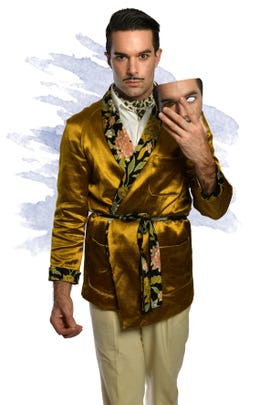
Milo McCabe is better known as Troy Hawke.
Steve Ullathorne
Milo McCabe, who goes by the stage name Troy Hawke, struck gold when he started making TikToks using a character he first invented eight years ago — a well-spoken greeter who stands outside of stores. McCabe is a Fringe veteran, but has returned to the Fringe this year to perform his show to sold-out rooms, with audiences who have come to ogle “the bloke from the video.”
“I’ve had to tweak it slightly and… make it a little bit easier to digest,” he said, noting his show is different from his TikToks. “That’s what I’ve been doing in the show day by day.”
Living for live
Many established comedians have yet to get on TikTok, unsure either of how to use it or whether there’s an audience for them on the app.
It turns out that TikTok is an ideal medium for comedians, as it gives them full creative control of their material so they ensure their jokes land as planned. McCabe has honed his editing skills, shaving off tenths of a second here and cutting anything that sounds inauthentic until it sounds “more fluid and watchable.”
Ricote is still trying to figure out a way to make TikTok work for her as someone who doesn’t do characters and wants to focus on standup. To get a closeup on your face, which she understands to be better for the algorithm, it means having a tripod setup close to her and performing for the camera while also performing for the audience. At this point, she said, “it’s not for the room anymore.”
Posting standup on TikTok at least partly takes away the purity of the art form, said Overman. “But at the same time we would all be lying to ourselves if we were saying that we didn’t want to reach a big audience. And it’s right there.”
For the majority of comedians wanting to make it big at Edinburgh or anywhere else in the world of comedy, finding an audience who will engage with them as they perform to sold-out rooms is always the end goal. While others on the app try to follow the well-trodden influencer pathway of acquiring enough followers to score brand partnerships, comics are largely avoiding monetizing their followings on the platform.
“For me,” said Gnome, “that’s not very interesting.” Rather than flogging products, she is motivated by the thrill of being in front of a real audience. “I’m really live oriented… so it really all does come back to the live thing.”
